
Birding Around Las Vegas, Desert National Wildlife Range

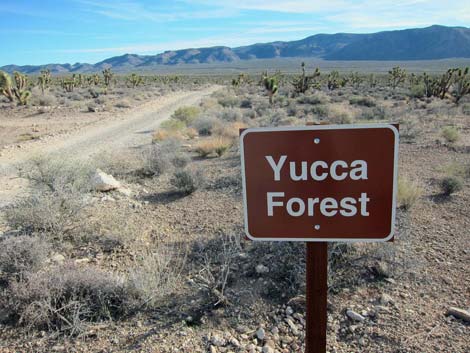 As seen from the summit of Yucca Peak (view SE) |
Overview The Yucca Forest is a broad, mid-elevation valley with a dense forest of Joshua Trees and Mojave Yucca traversed by the Mormon Well Road. The area gets a fair bit of rain, and the vegetation is relatively lush, all things considered, making this a good area to look for hard-core desert birds. As might be expected for a dry and seeming lifeless area, birds and other wildlife here are thinly distributed across the landscape. |
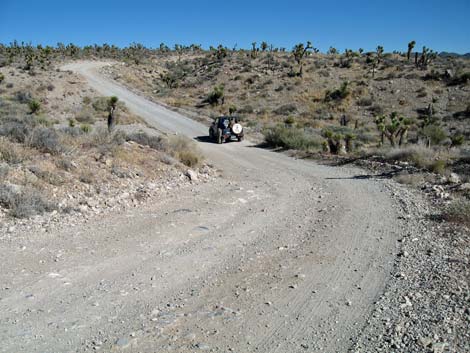 Birding the washes |
Description The Yucca Forest is a relatively high-elevation, broad, gently sloping valley with a dense forest of Eastern Joshua Trees, Banana Yucca, and Mojave Yucca, shrubs of various kinds, plus lots of bunchgrasses and forbs. Because of the elevation (generally exceeding 5,000 feet) and proximity to the mountains, the area gets a lot of rain relative to surrounding areas and the vegetation is relatively lush. The Yucca Forest lies between the Sheep Range (to the north and west) and the Las Vegas Range (to the south and east). The Las Vegas Range is the mountain range that forms the northern boundary of the Las Vegas Valley, and parts of the Yucca Forest can be seen from western parts of urban Las Vegas. Although you can see it from town, it is a long ride on a bumpy dirt road to get there, so you get the feeling of being "way out in the wilderness" by the time you arrive. |
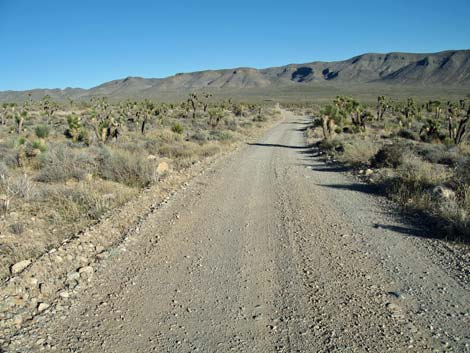 Good road in places |
The area is a National Wildlife Refuge, there are no developments, and the area feels very wild. This is a place to come to enjoy the solitude of the wilderness, look for Golden Eagles soaring among the limestone cliffs, listen to the wind in your ears, and spot a few desert birds and lizards. You don't have to go all the way to the "Yucca Forest" sign to get a feeling for the wildness of this area or to do a little desert birding. Getting up into or just past Yucca Gap is good enough. Getting into the Yucca Forest requires driving on a long, rough dirt road, and a high-clearance vehicle is required in all but the best of conditions. There are no services. If you go here, take at least a gallon of water per person, and expect to be the only humans out there. Be prepared to break down and spend a day waiting for help to find you. Cell phones mostly don't work. Read the Watch Out page for more information. |
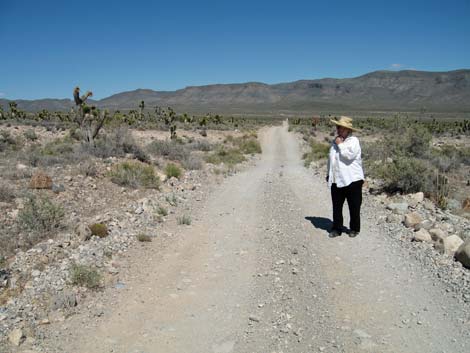 Birding the flats |
Location The Yucca Forest is located out in the desert, about 90 minutes north of downtown Las Vegas, but it seems a lot farther. From Corn Creek (Table 1, Site 106), continue eastward for about 50 yards to a T-intersection. Turn south (right) onto Mormon Wells Road, which runs south for about 0.3 miles before bending to the east (left) and starting up the bajada towards Yucca Gap (the gap through the mountains seen in the distance ahead). About 0.2 miles past the bend, the road passes the turnoff to the Old Corn Creek Picnic Area with several tall Cottonwood Trees and a spring. This can be a good place to stop to bird for a few minutes, but look from afar because the area is now closed to entry. |
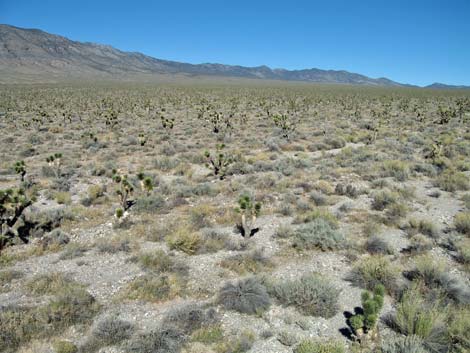 A sea of Joshua Trees |
Continuing east about 4.5 miles brings you to Yucca Gap, the gap in the mountains between the Sheep Range (north) and Fossil Ridge of the Las Vegas Range (south). Be sure to stop along Fossil Ridge and look for fossils where the road runs right along the cliffs. This can be another good place to stop to bird for a few minutes. Driving on, the land opens up as the road enters the Yucca Forest. The road curves to the north, does a few jogs back and forth to get past some washes, and then generally heads northeast and out across the valley. About 15 miles out from Corn Creek, you get to an intersection with Pine Nut Road (Site 0424). This is a good place to stop, get out, wander about, and look for birds. When ready, turn around here and drive back across the valley, stopping frequently to get out of your car and look for birds. The washes, which generally have more vegetation than the flats, are good places to look for birds. |
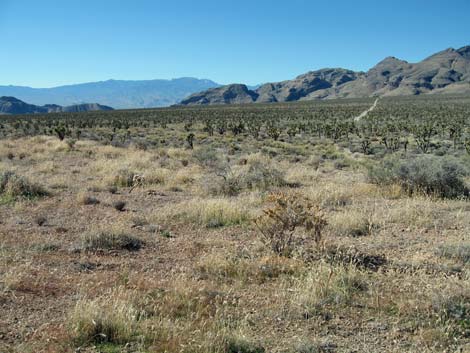 Mormon Well Road and Joshua Trees (view SW) |
Hours Always open, but consider the refuge to be day-use unless you are camping. Fees None. Specialties This is a good area for finding hard-core desert birds. There are no particular places to stop, but the scenery is spectacular, and the intersection of the Mormon Well and Pinenut roads always has been a good spot. Watch for Golden Eagles around the cliffs, and watch for Scott's Orioles, Ash-throated Flycatchers, Cactus Wrens, Black-throated Sparrows, Sage Sparrows, Horned Larks, and Northern Mockingbirds in the Yucca Forest. I've even seen Pinyon Jays here. |
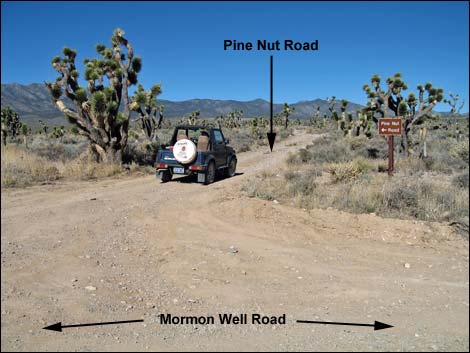 Mormon Well Road at Pine Nut Road (view N) |
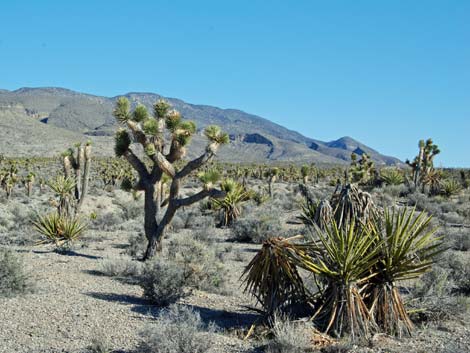 Typical Yucca Forest habitat (view N) |
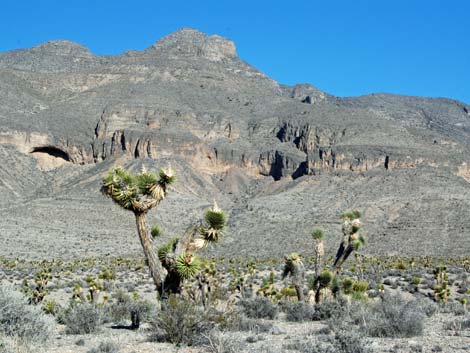 |
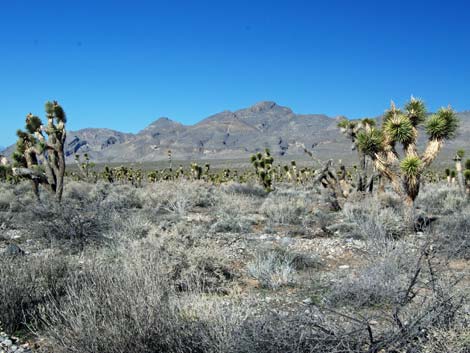 |
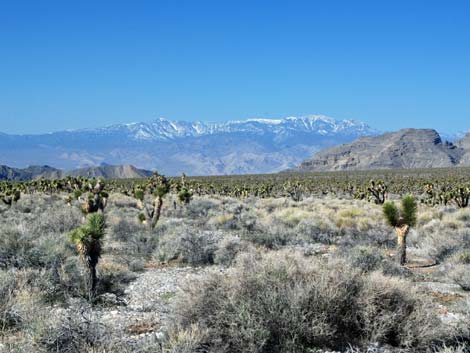 |
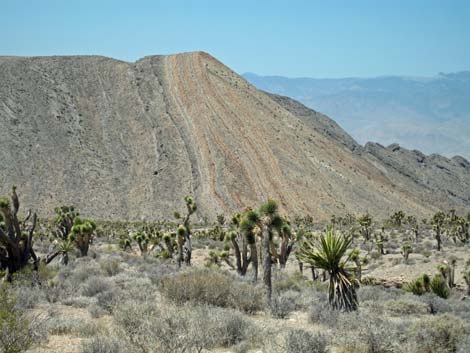 |
Table 1. GPS Coordinates for Highway Locations (NAD27; UTM Zone 11S). Download Highway GPS Waypoints (*.gpx) file.
| Site # | Location | Latitude (°N) | Longitude (°W) | UTM Easting | UTM Northing | Elevation (feet) | Verified |
|---|---|---|---|---|---|---|---|
| 0106 | Corn Creek parking area | 36.4383 | 115.3575 | 647223 | 4033617 | 2,814 | Yes |
| 0424 | Mormon Well Rd at Pinenut Rd | 36.5016 | 115.1644 | 664399 | 4040953 | 5,282 | Yes |
Happy birding! All distances, elevations, and other facts are approximate.
![]() ; Last updated 240708
; Last updated 240708
| Birding DNWR | Birding Around Las Vegas | So. NV Birds | Copyright, Conditions, Disclaimer | Home |